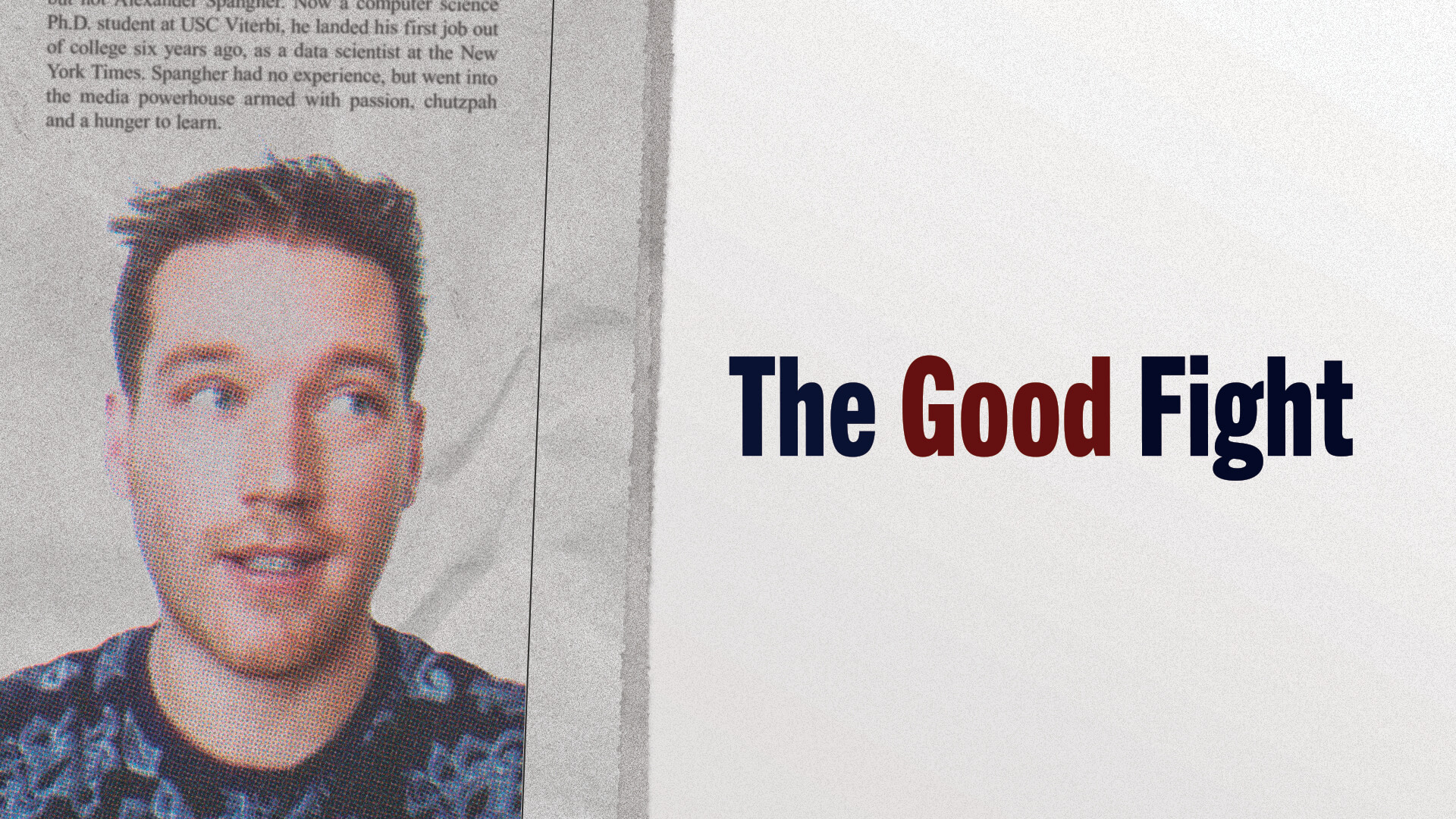The Good Fight
MOST OF US muddle along in the early days of our career, but not Alexander Spangher. Now a computer science Ph.D. student at USC Viterbi, he landed his first job out of college six years ago, as a data scientist at the New York Times. Spangher had no experience, but went into the media powerhouse armed with passion, chutzpah and a hunger to learn.
“Every time you walk through those doors, you can sense this feeling of mission and urgency,” said Spangher, who recently received the Bloomberg Data Science Ph.D. Fellowship. “There’s a bunch of people that all believe they’re doing the right thing, which is really inspiring.”
Working alongside reporters, Spangher saw the shortcomings faced by traditional newsrooms: sourcing and gathering material under tight budgets and in an evolving media landscape.
“There is strong academic evidence that the stronger the press, the less corruption exists in a country,” said Spangher. “So, as news staff decline, we also see a decline in the public’s ability to monitor power. It’s very serious.”
Spangher was motivated to discover how computer science, which he had studied as an undergraduate at Columbia University, could help make the press stronger, even in the face of budget cuts.
Soon, what started as a 9 to 5 job became a personal mission: to develop computational tools to bring AI to the newsroom. He decided to go back to school to earn his Ph.D..
Planting a seed
Journalism and computer science are Spangher’s passions, but music is his first love. Growing up on Long Island, the son of a psychology professor and an emergency room physician, Spangher studied double bass and piano with professors from Juilliard and the New York Philharmonic.
He embarked on a computer science and neuroscience degree at Columbia, where one professor planted a seed. “His name was Bob Neer and he waxed nostalgic about his time working for the school newspaper and the meaning of journalism. I got curious,” Spangher recalls.
That curiosity led him to write for the student newspaper, The Columbia Spectator, and then intern at The Huffington Post as a back-end engineer. The experience paved a path to the Times, where he also worked on tools that helped both readers discover articles and journalists find stories.
For Spangher, seeing the struggles, integrity and purpose that his journalist colleagues brought to their jobs, even as the workforce was suffering layoffs, threw his beginner’s luck — and privilege — into stark relief.
“I’m this white, young, male data scientist being hired when veteran reporters were getting laid off. It was dispiriting, to say the least, and it felt very unfair,” he said.
He also saw the shortcomings of the current technologies available to newsrooms, lagging behind other major industries, as well as the crushing economics of the news industry destroying local journalism. The combination helped Spangher crystalize the focus of his future career: to help reporters in their work and create a more just and equal society. He started taking part-time master’s classes in journalism and data science at his alma mater.
“I felt like the whole field of computer science was really focused on the needs of a couple of big tech companies and government agencies, because they’re the ones that set the agendas, but with small tweaks, the same techniques could be directly relevant to journalism,” said Spangher. “It felt like there was a small gap there that could have huge consequences.”
A human business
In 2017, he made the bold move to leave the newspaper to earn his Ph.D. He started at Carnegie Mellon, working at the NASA Ames Research Park campus in Silicon Valley, and interned at Microsoft in 2018, researching fake news and Russian propaganda in the 2016 US presidential election.
During this time, one name kept coming up in his studies: Emilio Ferrara, a professor of computer science at USC. Spangher reached out to Ferrara to see if he would be interested in working with him. The reply came quickly — a resounding “yes.” A few months later, Spangher was formally accepted to USC.
While Spangher is now a computer scientist by trade, his goal is not to create AI to write news stories, but to make it easier for reporters to get on with the human business of reporting. One way data science can help, he said, is by looking for patterns in past stories.
At USC Viterbi, he has worked on developing systems to help reporters find newsworthy leads, tee up relevant and diverse sources, and automatically detect if companies and governments are upholding the law and their promises to the public.
He has also tackled big, hot-topic issues — including the effects of various policy approaches to the coronavirus outbreak — by analyzing social media using natural language processing, a subfield of AI.
“The first step is always to prove that machine learning can help, but the next step is to say, OK, how can I help in the right way?” said Spangher, who hopes to continue this line of research after earning his Ph.D., either with a news agency or as a professor.
“Everything that I do is deeply focused on empowering journalists and keeping them in the loop, not doing any sort of complete end-to-end like machine processes, like writing news stories from start to finish,” he said.
“There’s always going to need to be a human that connects with the source gets the source to talk, writes the compelling lead and hooks the reader,” Spangher added. “Conversation is an intimately human process. I mean, the Turing test is a test for a reason.”




